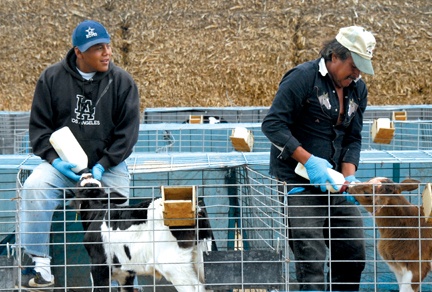Feeding dairy calves three times per day (3x) rather than two is quickly rising in popularity, according to results of a recent nationwide survey. It's a practice that benefits both calves and their owners.

Two-times feeding has been standard practice for dairies and commercial calf ranches more or less forever. It's a system that fits well into human work schedules but generally prevents calves from growing as fast and efficiently as they could. If left with their mothers (not a good idea because it increases disease risk), calves will typically nurse 4 to 8 times per day.
Perhaps the biggest downside to 2x calf feeding is the extra stress that occurs during winter. Windy, wet and cold weather can double the daily calorie needs of calves. Not getting them results in weight loss, increased sickness, and greater risk of death.
To meet those additional nutritional needs, a few dairies and calf ranches have always fed 3x. Those who do so tend to swear by it. Three-times takes more labor and expense, but calves thrive, and there is much less sickness and death. Many studies have also found that calves fed 3x produce about 10 percent more milk during their first lactation.
According to a recent nationwide study by Merck Animal Health, the number of people feeding calves 3x is rising fast. In 2007, a survey by the National Animal Health Monitoring System found just 5.4 percent of calf raisers feed 3x. Three years later, however, the Merck study found 8 percent of respondents feed 3x all year and 14 percent do so during winter.
That's a growth trend we hope continues because it makes both dollars and sense for everyone who raises calves.

Two-times feeding has been standard practice for dairies and commercial calf ranches more or less forever. It's a system that fits well into human work schedules but generally prevents calves from growing as fast and efficiently as they could. If left with their mothers (not a good idea because it increases disease risk), calves will typically nurse 4 to 8 times per day.
Perhaps the biggest downside to 2x calf feeding is the extra stress that occurs during winter. Windy, wet and cold weather can double the daily calorie needs of calves. Not getting them results in weight loss, increased sickness, and greater risk of death.
To meet those additional nutritional needs, a few dairies and calf ranches have always fed 3x. Those who do so tend to swear by it. Three-times takes more labor and expense, but calves thrive, and there is much less sickness and death. Many studies have also found that calves fed 3x produce about 10 percent more milk during their first lactation.
According to a recent nationwide study by Merck Animal Health, the number of people feeding calves 3x is rising fast. In 2007, a survey by the National Animal Health Monitoring System found just 5.4 percent of calf raisers feed 3x. Three years later, however, the Merck study found 8 percent of respondents feed 3x all year and 14 percent do so during winter.
That's a growth trend we hope continues because it makes both dollars and sense for everyone who raises calves.








